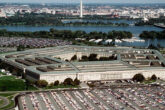
April 04, 2017
Michèle Flournoy before the House Committee on Armed Services
Assessing Progress and Identifying Future Opportunities in Defense Reform
Chairman Thornberry, Ranking Member Smith, distinguished members of the House Armed Services Committee, it is truly an honor to testify before you today on the critical topic of defense reform.
It is hard to remember a time when the need for defense reform was more acute. The growing challenges the U.S. armed forces face in protecting American interests, values, and allies in the coming years are truly daunting: the spread of the Islamic State, al Qaeda, and other violent extremist groups; the turmoil in the Middle East; the resurgence of a more aggressive Russia; the rise of a more capable and assertive China that is challenging the rules-based international order in Asia; persistent threats from states like Iran and North Korea; the continued proliferation of deadly technologies to both state and non-state actors; and the emergence of new threats in the cyber and space domains – just to name a few. With strong leadership on defense issues in both the Senate and the House and a sitting Secretary of Defense who is willing to pursue fundamental reforms, now is the time to develop and implement a plan of action to ensure we get the most out of every taxpayer dollar invested in defense. I am glad to see that the members of this committee, Republican and Democrat, share this sense of urgency.
Over the past few years, this committee has lead the charge to reform how the Department of Defense does business in an effort to strengthen the U.S. military and deliver greater value to the American taxpayer. Creating a more agile and cost-effective DoD acquisition system has been a top priority, with this committee formulating a number of the critical reforms that were the hallmark of last year’s defense authorization bill. Given the scope and complexity of the changes DoD must now make to its acquisition organization, culture, and practices, I would advocate that the committee give the new Secretary of Defense and his team this year for implementation and consolidation, with close consultation with this committee to ensure the desired impacts and benefits are realized. In the meantime, this committee has an opportunity to use this legislative cycle to examine and advance a number of other critical defense reform initiatives.
Even in a period when the defense budget is likely to increase, I would urge this committee to continue to be aggressive in pursuing a robust defense reform agenda. Although our military is more capable than ever before, its current cost curve is not sustainable. Fundamental defense reforms are needed to free up resources for reinvestment in the people, concepts of operations, and capabilities that will enable us to maintain our military-technological edge in the face of a much more challenging future security environment. Even in an era of modestly higher defense budgets, fundamental trade-offs will have to be made. That is why it is so important that Secretary of Defense Mattis and this committee partner to drive strategy-driven choices and continued progress on defense reform.
Defense reform is, as they say, a “target rich environment.” There is a wealth of opportunities to improve the performance and cost-effectiveness of the defense enterprise. They are not necessarily easy, but they are plentiful. Knowing that my fellow witnesses on this panel may focus on other areas such as reform of the military compensation and retirement system, financial and cost-accounting reforms, acquisition reform, or reforms to the military personnel system, I have chosen to focus on four other areas that I believe should be priorities in any defense reform agenda because they meet two key criteria: they have high potential to improve DoD’s performance and they are likely to free up substantial resources that can be reinvested in higher priority areas. My four areas of focus today are: rightsizing headquarters and transforming defense agencies; reducing excess infrastructure; reshaping and reinvigorating the civilian work force; and improving the quality and cost-effectiveness of military health care.
The full Congressional testimony is available online.
More from CNAS
-
Lessons in Learning
Executive Summary Although claims of a revolution in military affairs may be overhyped, the potential for artificial intelligence (AI) and autonomy to change warfare is growin...
By Josh Wallin
-
The Pentagon Push to Change an “Antiquated” System
Carlton Haelig, a fellow at the Center for a New American Security, joined The Cipher Brief to discuss the systems in place in the Department of Defense and the challenges ass...
By Carlton Haelig
-
The Department of Defense’s Breakthrough Nuclear Moment Risks Slipping Away
Unless they act, the Department of Defense’s breakthrough nuclear moment may vanish before it really happens....
By Will Rogers
-
DEFAERO Strategy Series [Apr 09, 25] CNAS' Becca Wasser and Phil Sheers on Revitalizing the U.S. Defense Industrial Base
On this episode of the Defense & Aerospace Report Strategy Series, sponsored by General Atomics Aeronautical Systems, Becca Wasser and Phil Sheers of the Center for a New Amer...
By Becca Wasser & Philip Sheers




